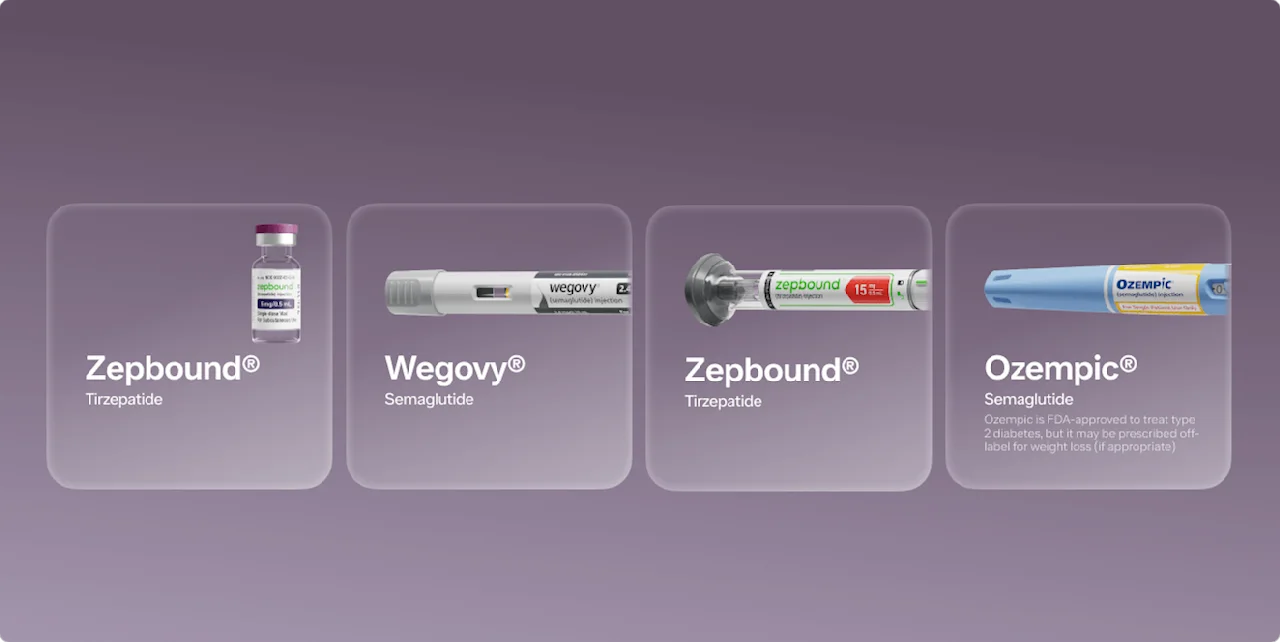Key takeaways
At the time of publication, there isn’t a Wegovy shortage; as all five dosage strengths are available, according to the US Food and Drug Administration (FDA).
While the weight loss medication should be in stock, supply can vary locally, which can cause delays in filling prescriptions at your nearby pharmacy.
Wegovy alternatives include other injectable medications that are FDA-approved for chronic weight management (e.g. Zepbound, Saxenda) as well as those that may be prescribed off-label (e.g. Ozempic, Mounjaro, Victoza).
Certain oral weight loss medications (e.g. Qsymia, Contrave) may also be prescribed for weight loss and management as Wegovy alternatives.
Here's what we'll cover
Here's what we'll cover
Key takeaways
At the time of publication, there isn’t a Wegovy shortage; as all five dosage strengths are available, according to the US Food and Drug Administration (FDA).
While the weight loss medication should be in stock, supply can vary locally, which can cause delays in filling prescriptions at your nearby pharmacy.
Wegovy alternatives include other injectable medications that are FDA-approved for chronic weight management (e.g. Zepbound, Saxenda) as well as those that may be prescribed off-label (e.g. Ozempic, Mounjaro, Victoza).
Certain oral weight loss medications (e.g. Qsymia, Contrave) may also be prescribed for weight loss and management as Wegovy alternatives.
If you’re reading this article, you’re probably looking for alternative medications to Wegovy (semaglutide). Maybe you’re tired of scrambling to fill your prescription during a shortage. Or maybe the weight loss drug is too expensive or not covered by insurance. Or maybe (yes, another maybe) you’re just someone who likes to be prepared.
Whatever the reason for your interest in Wegovy and similar medications, you’ve come to the right place. Below, we share the status of the Wegovy shortage and offer advice for finding the drug in stock as well as other medications that you can discuss with your healthcare provider.
Wegovy Important Safety Information: Read more about serious warnings and safety info.
Is there a Wegovy shortage?
At the time of publication, all five dosage strengths of Wegovy—0.25 mg, 0.5 mg, 1.0 mg, 1.7 mg, and 2.4 mg—are listed as “available” on the US Food and Drug Administration (FDA) Drug Shortages database. Keep in mind, though, you may still have difficulty filling your prescription at your local pharmacy because supply can vary among locations.
Now, you might be wondering what the current Wegovy shortage (or lack thereof) means for certain doses of Ozempic (which also contains semaglutide). After all, both drugs contain semaglutide and have experienced shortages since 2022—plus, Ozempic can be prescribed off-label for weight loss and, like Wegovy, is FDA-approved to reduce heart attack and stroke risks in certain populations. The answer? No; as of publication, all doses of Ozempic are listed as “available” on the FDA’s Drug Shortages database. Wegovy and Ozempic differ in their dosage strengths and their indications.
Ozempic is FDA-approved to control blood sugar levels in adults with type 2 diabetes mellitus alongside diet and exercise. It can also be prescribed to lower the risk of major cardiovascular problems (e.g. heart attack, stroke) in adults with type 2 diabetes and heart disease.
Wegovy is FDA-approved to help with weight loss and management in adults and children ages 12+ with obesity as well as adults with obesity or overweight who have at least one weight-related health condition (e.g. high blood pressure, diabetes). It can also be prescribed to lower the risk of major cardiovascular problems (e.g. heart attack, stroke) in adults with heart disease and obesity, even without type 2 diabetes.
If you have concerns about filling your prescription of Wegovy during a shortage, talk to your healthcare provider.
Ozempic Important Safety Information: Read more about serious warnings and safety info.
7 Wegovy alternatives
There are several alternatives you can take instead of Wegovy to lose weight, including other injectable medications for weight loss as well as prescription oral weight loss drugs and appetite suppressants. Additionally, some GLP-1 medications that are FDA-approved for type 2 diabetes (see: Ozempic) may be prescribed off-label for weight loss.
GLP-1 stands for glucagon-like peptide-1 (GLP-1) receptor agonist. It’s the category of drugs that includes Wegovy. GLP-1 medications can help with weight loss by slowing down digestion so you feel full sooner and eat less. They can also affect the parts of your brain involved in appetite regulation, which can help reduce cravings.
Since several of the Wegovy alternatives on this list are also GLP-1 medications, they tend to have similar side effects to Wegovy, including nausea, vomiting, abdominal pain, diarrhea, constipation, and injection site reactions (e.g. pain or skin irritation). Typically, these side effects are most intense and frequent when you start using the medications and when increasing your dose. They tend to lessen with time as your body gets used to the drug.
Unlike the GLP-1 alternatives to Wegovy, which are injectable drugs like Wegovy, the appetite suppressants on this list are oral medications. They share some side effects with Wegovy, including constipation, nausea, and vomiting. However, they may also produce side effects such as dry mouth, insomnia, and changes to your stool.
1. Saxenda (liraglutide)
Like Wegovy, Saxenda (liraglutide) is a GLP-1 receptor agonist, so it works similarly and has similar gastrointestinal side effects. One key difference between these two medications is how often you inject them: Saxenda is a daily medication, while Wegovy is weekly.
In a large-scale review of over 20 randomized controlled trials, the highest dose of Wegovy (2.4 mg) consistently outperformed the highest dose of Saxenda (3.0 mg) when it came to weight loss, with those taking semaglutide losing more than twice as much weight as those taking Saxenda. Still, people taking Saxenda lose a significant amount of weight—about 5% to 7.5% of their body weight in a year—and they often experience fewer side effects than those using Wegovy.
Another, lower-dose version of liraglutide (the active ingredient in Saxenda) is marketed as Victoza. This medication is FDA-approved to treat type 2 diabetes, but may be prescribed off-label for weight loss as well. Clinical studies generally show that people taking Victoza lose around 5-6% of their body weight in one year.
Cost: Saxenda has the same list price as Wegovy, meaning it costs $1,349.02 without insurance. The Saxenda Savings Card offered by Novo Nordisk (which also makes Saxenda) can bring the cost down to as low as $25 for those with commercial insurance.
Current availability: Saxenda is currently in shortage until “TBD,” according to the FDA’s Shortages website.
Saxenda Important Safety Information: Read more about serious warnings and safety info.
2. Zepbound (tirzepatide)
Like Wegovy, Zepbound (tirzepatide) is an injectable medication for weight loss. It’s a dual GLP-1/GIP receptor agonist, which refers to the fact that it targets two hormone receptors, as opposed to just one. This may explain why it may be the most effective among GLP-1 medications for weight loss.
Indeed, studies have found that while both Wegovy and Zepbound reduce appetite, Zepbound produces more weight loss. A study found that over the course of a year and a half, participants with type 2 diabetes taking 15 mg of tirzepatide (the active ingredient in Zepbound) lost nearly 18% of their body weight compared with 12.4% for those taking 2.4 mg of semaglutide. Based on these results, the researchers concluded that tirzepatide can be a more cost-effective treatment for weight reduction.
Zepbound shares similar side effects with Wegovy, including nausea, vomiting, diarrhea, and constipation.
Cost: With a list price of $1,086.37 per month, Zepbound costs less than Wegovy. The Zepbound Savings Card, which is available via drug manufacturer Eli Lilly, offers additional savings for people with commercial insurance (with or without coverage for Zepbound). Zepbound single-dose vials, which are available through Ro and LilyDirect, have a cash price of $399 per month for the 2.5 mg dose and $549 per month for the 5 mg dose.
Current availability: At the time of publication, all dosage strengths of Zepbound are available, according to the FDA Drug Shortages database. Despite this availability, however, patients prescribed Zepbound might still have difficulty filling their Rx because supply can (and often does) vary among pharmacies.
Zepbound Important Safety Information: Read more about serious warnings and safety info.
3. Qsymia (phentermine/topiramate)
Qsymia (phentermine/topiramate) is a stimulant that can promote weight loss when used with a low-calorie diet and exercise. One study showed that about 40% of people can lose about 5% of their body weight within five months of starting Qsymia.
Qsymia is an oral medication you take once a day with or without food. Because it’s a stimulant and boosts energy, the drug should be taken in the morning. Common side effects include feelings of tingling or prickling, dizziness, changes in taste, insomnia, constipation, and dry mouth. It’s important to note that one of the main ingredients in Qsymia is phentermine, a Schedule IV controlled substance, which means this drug carries a potential risk of abuse and dependence.
Cost: Without insurance, the cost of Qsymia is $134 for a 30-day supply. Those with commercial insurance with or without coverage for Qsymia can get a month’s worth of the drug for as little as $75 when using the Qsymia Savings Card.
Current availability: As of publication, there is no drug shortage affecting Qsymia.
4. Contrave (naltrexone/bupropion)
Another FDA-approved weight loss pill, Contrave (naltrexone/bupropion) is an oral medication that’s taken twice a day. Research suggests the effects of Contrave can be seen after just 4 weeks of using the medication. After 16 weeks, roughly 45% of participants experienced a 5% or greater reduction in body weight. Indirectly compared to Qsymia, however, Contrave tends to produce slightly less weight loss, though these two drugs have not been compared head-to-head in a clinical trial. Another study examined the potential results of the two drugs and found that participants taking Contrave experienced a 2.6% reduction in body weight while those taking Qsymia experienced a 3.6% reduction over the course of more than 12 weeks.
Side effects with Contrave may include nausea, constipation, headache, vomiting, dizziness, insomnia, dry mouth, diarrhea, or suicidal thoughts.
Cost: The average cost of Contrave without insurance can range from $690 to $750 per month. The Contrave Savings Coupon Card can provide additional savings for people with commercial insurance (with or without coverage for Contrave).
Current availability: As of publication, there is no drug shortage affecting Contrave.
5. Xenical (orlistat)
Xenical (orlistat) is an oral medication taken three times a day with food. The drug reduces your body’s absorption of fat, which makes it effective at helping people lose weight. One study suggests that people taking orlistat can lose about 2% of their body weight within five months and 5% or more over the long term.
Like many weight loss medications, Xenical can have gastrointestinal side effects, including flatulence (sometimes with oily spottings), diarrhea, loose or greasy stool, and frequent or uncontrollable bowel movements.
Cost: The average cost of Xenical tends to be around $466 for 90 capsules, according to Drugs.com. Just like with any other drug, however, the exact price of Xenical can vary depending on factors, such as your location, pharmacy, and insurance (if any). There is a generic version available, which may be cheaper.
Current availability: As of publication, there is no drug shortage affecting Xenical.
6. Compounded semaglutide
Compounded medications are tailor-made by licensed pharmacists to suit specific patient needs when no suitable commercial alternative exists. Although they are legally prescribable, these medications are not subject to FDA approval, meaning they don't undergo the same rigorous testing for safety, efficacy, or manufacturing standards as commercially available drugs. Healthcare providers might recommend compounded treatments in situations such as drug shortages or to meet the needs of individual patients.
Not only does it share the same active ingredient (semaglutide) as Wegovy, but compounded semaglutide is also available as a once-weekly injectable prescription medication. While compounded medications aren’t typically covered by insurance, compounded semaglutide can be a more affordable option compared to Wegovy—but more on that in a second. If you and your healthcare provider decide that compounded semaglutide could be a good Wegovy alternative for you, you’ll want to confirm that it is prepared by a reputable compounding pharmacy that is based in the US and requires a prescription from a licensed health provider.
Cost: Varies depending on where you fill your prescription.
Current availability: Availability differs depending on where you get and fill the Rx.
7. Other GLP-1 medications
Currently, Zepbound, Saxenda, and Wegovy are the only GLP-1 medications specifically FDA-approved for weight loss and management. Other GLP-1 agonists are FDA-approved for type 2 diabetes. But they can also result in weight loss and may be prescribed off-label for this purpose. For example:
Ozempic (semaglutide): Ozempic contains the same active ingredient as Wegovy, but is prescribed in slightly lower dosage amounts. (The maximum dose of Ozempic is 2 mg weekly vs. 2.4 mg weekly for Wegovy).
Mounjaro (tirzepatide): Mounjaro contains the same active ingredient as Zepbound (tirzepatide); it is also prescribed in the same dosage amounts. There hasn’t been a study comparing Wegovy and Mounjaro for weight loss directly. However, in a study of people with type 2 diabetes, the highest doses of tirzepatide was associated with more weight loss than the 2 mg dose of semaglutide.
Mounjaro Important Safety Information: Read more about serious warnings and safety info.
Trulicity (dulaglutide): Like Wegovy, Trulicity is a weekly injectable medication. In studies of people with type 2 diabetes and obesity or overweight, participants lost about half as much when taking dulaglutide (the active ingredient in Trulicity) compared to when talking semaglutide (the active ingredient in Wegovy)—even on the lower doses of semaglutide.
Cost: All three medications can be cheaper than Wegovy.
The list price of Ozempic is $997.58 for a 28-day supply. The Ozempic Savings Card can provide additional savings for people with commercial or private insurance.
The list price of Mounjaro is $1,079.77 per month. The Mounjaro Savings Card can provide additional savings for people with commercial insurance with or without coverage for Mounjaro.
The list price of Trulicity is $986.19 per month. The Trulicity Savings Card can provide additional savings for people who have commercial insurance with coverage for Trulicity.
Current availability:
All dosage strengths of Ozempic are available, per the FDA.
All dosage strengths of Mounjaro are currently available, per the FDA.
While dulaglutide (the active ingredient in Trulicity) is categorized as “currently in shortage,” all dosage strengths of Trulicity are available, per the FDA.
What to do if you have to stop Wegovy
Let’s be very clear: You shouldn’t stop taking Wegovy (or any medication for that matter) without first consulting a healthcare professional. If the Wegovy shortage disrupts your treatment, talk to your healthcare provider as soon as possible. They may be able to help you fill your prescription or get you started on an alternative to Wegovy, such as one of those above.
Wegovy has a half-life of about one week, and it will take even longer for the drug to fully flush out of your system. Once this happens, you may also feel your appetite return as well as some weight gain.
Whether forced to stop the medication due to the Wegovy shortage or another reason, be sure to stick with the lifestyle changes you implemented during treatment, such as following a healthy, balanced diet and regularly exercising. These positive habits can help you keep off the weight you lost and potentially help you lose more.
Bottom line
Given the high demand for the drug, Wegovy experiences shortages from time to time. But there are other alternative medications available, including injectable GLP-1s as well as weight loss pills. If you’re concerned the Wegovy shortage may affect your access to the drug, contact your health provider. Ask them about your options and whether another medication, such as the Wegovy alternatives above, may work for you.
DISCLAIMER
If you have any medical questions or concerns, please talk to your healthcare provider. The articles on Health Guide are underpinned by peer-reviewed research and information drawn from medical societies and governmental agencies. However, they are not a substitute for professional medical advice, diagnosis, or treatment.
Azuri, J., Hammerman, A., Aboalhasan, E., et al. (2023). Tirzepatide versus semaglutide for weight loss in patients with type 2 diabetes mellitus: A value for money analysis. Diabetes, Obesity & Metabolism, 25(4), 961–964. doi: 10.1111/dom.14940. Retrieved from https://pubmed.ncbi.nlm.nih.gov/36507900/
Chudleigh, R. A., Platts, J., & Bain, S. C. (2020). Comparative Effectiveness of Long-Acting GLP-1 Receptor Agonists in Type 2 Diabetes: A Short Review on the Emerging Data. Diabetes, Metabolic Syndrome and Obesity: Targets and Therapy, 13, 433–438. doi: 10.2147/DMSO.S193693. Retrieved from https://www.ncbi.nlm.nih.gov/pmc/articles/PMC7035886/
Contrave. (2024). CurAccess Program: Pay $99 Or Less + FREE Shipping.* Retrieved from https://contrave.com/save/
Drugs.com. (n.d.). Xenical price guide. Retrieved from https://www.drugs.com/price-guide/xenical
Eli Lilly-a. (2024). How much should I expect to pay for Mounjaro?. Retrieved from https://pricinginfo.lilly.com/mounjaro
Eli Lilly-b. (2024). How much should I expect to pay for Trulicity?. Retrieved from https://pricinginfo.lilly.com/trulicity
Eli Lilly-c. (2024). How much should I expect to pay for Zepbound?. Retrieved from https://pricinginfo.lilly.com/zepbound
GoodRx-a. (2024). Contrave (Naltrexone & Bupropion) Prices, Coupons & Savings Tips. Retrieved from https://www.goodrx.com/contrave?form=tablet&dosage=8mg-90mg&quantity=120&label_override=contrave
GoodRx-b. (2024). Xenical Prices, Coupons & Savings Tips. Retrieved from https://www.goodrx.com/xenical?)label_override=xenical&form=capsule&dosage=120mg&quantity=90&slug=xenicallabel_override=xenical&form=capsule&dosage=120mg&quantity=90&slug=xenical)
Gorgojo-Martínez, J. J., Mezquita-Raya, P., Carretero-Gómez, J., et al. (2022). Clinical Recommendations to Manage Gastrointestinal Adverse Events in Patients Treated with Glp-1 Receptor Agonists: A Multidisciplinary Expert Consensus. Journal of Clinical Medicine, 12(1), 145. doi: 10.3390/jcm12010145. Retrieved from https://www.ncbi.nlm.nih.gov/pmc/articles/PMC9821052/
Grabarczyk, T. R. (2018). Observational Comparative Effectiveness of Pharmaceutical Treatments for Obesity within the Veterans Health Administration. Pharmacotherapy, 38(1), 19–28. doi: 10.1002/phar.2048. Retrieved from https://pubmed.ncbi.nlm.nih.gov/29044720/
le Roux, C. W., Fils-Aimé, N., Camacho, F., et al. (2022). The relationship between early weight loss and weight loss maintenance with naltrexone-bupropion therapy. EClinicalMedicine, 49, 101436. doi: 10.1016/j.eclinm.2022.101436. Retrieved from https://www.thelancet.com/journals/eclinm/article/PIIS2589-5370(22)00166-3/fulltext
Mounjaro. (2024). Savings & Resources. Eli Lilly. Retrieved from https://mounjaro.lilly.com/savings-resources#savings
National Association of Boards of Pharmacy. (2023). Diabetes Drug Shortages and Fake Ozempic. National Association of Boards of Pharmacy. Retrieved from https://nabp.pharmacy/news/blog/diabetes-drug-shortages-and-fake-ozempic/
Novo Nordisk. (2024). Supply update. Retrieved from https://www.novonordisk-us.com/supply-update.html
NovoCare-a. (2023). Ozempic Cost. Novo Nordisk. Retrieved from https://www.novocare.com/ozempic/let-us-help/explaining-list-price.html
NovoCare-b. (2023). What is the list price for Saxenda and will it impact me? Novo Nordisk. Retrieved from https://www.novocare.com/obesity/products/saxenda/explaining-list-price.html
NovoMedlink. (2023). Saxenda (liraglutide) Injection 3 Savings Card for Patients. Novo Nordisk. Retrieved from https://www.novomedlink.com/obesity/products/treatments/saxenda/cost-coverage/patient-savings.html
Ozempic. (2023). Ozempic Savings Card. Novo Nordisk. Retrieved from https://www.ozempic.com/savings-and-resources/save-on-ozempic.html
Pi-Sunyer, X., Astrup, A., Fujioka, K., et al. (2015). A Randomized, Controlled Trial of 3.0 mg of Liraglutide in Weight Management. The New England Journal of Medicine, 373(1), 11–22. doi: 10.1056/NEJMoa1411892. Retrieved from https://pubmed.ncbi.nlm.nih.gov/26132939/
Qsymia.com. (n.d.). Multiple ways to save on Qsymia. Retrieved from https://qsymia.com/patient/multiple-ways-to-save
Rodriguez, P. J., Goodwin Cartwright, B. M., Gratzl, S., et al. (2024). Semaglutide vs Tirzepatide for Weight Loss in Adults With Overweight or Obesity. JAMA Internal Medicine, 184(9), 1056–1064. doi: 10.1001/jamainternmed.2024.2525. Retrieved from https://jamanetwork.com/journals/jamainternalmedicine/fullarticle/2821080
Shibuya, K., Ali, K. F., Ji, X., et al. (2019). THE BENEFIT OF SHORT-TERM WEIGHT LOSS WITH ANTI-OBESITY MEDICATIONS IN REAL-WORLD CLINICAL PRACTICE. Endocrine Practice, 25(10), 1022–1028. doi: 10.4158/EP-2019-0081. Retrieved from https://pubmed.ncbi.nlm.nih.gov/31241358/
Singh, G., Krauthamer, M., & Bjalme-Evans, M. (2022). Wegovy (semaglutide): a new weight loss drug for chronic weight management. Journal of Investigative Medicine, 70(1), 5–13. doi: 10.1136/jim-2021-001952. Retrieved from https://www.ncbi.nlm.nih.gov/pmc/articles/PMC8717485/
Trulicity. (2024). Trulicity Savings Card, Cost and Resources. Eli Lilly. Retrieved from https://trulicity.lilly.com/savings-resources
U.S. Food and Drug Administration (FDA-a). (2021). CONTRAVE (naltrexone hydrochloride and bupropion hydrochloride) extended-release tablets, for oral use. Retrieved from https://www.contravehcp.com/wp-content/uploads/Contrave_PI.pdf
U.S. Food and Drug Administration (FDA-a). (2024). Drug Shortages: Dulaglutide Injection. Retrieved from https://dps.fda.gov/drugshortages/activeingredient/dulaglutide-injection
U.S. Food and Drug Administration (FDA-b). (2024). Drug Shortages: Liraglutide Injection. Retrieved from https://dps.fda.gov/drugshortages/activeingredient/liraglutide-injection
U.S. Food and Drug Administration (FDA-c). (2024). Drug Shortages: Semaglutide Injection. Retrieved from https://dps.fda.gov/drugshortages/activeingredient/semaglutide-injection
U.S. Food and Drug Administration (FDA-d). (2024). Drug Shortages: Tirzepatide Injection. Retrieved from https://dps.fda.gov/drugshortages/resolved/tirzepatide-injection
U.S. Food and Drug Administration (FDA). (2022). QSYMIA (phentermine and topiramate extended-release capsules), for oral use, CIV. Retrieved from https://www.accessdata.fda.gov/drugsatfda_docs/label/2022/022580s021lbl.pdf
U.S. Food and Drug Administration (FDA-a). (2020). SAXENDA (liraglutide) injection, for subcutaneous use. Retrieved from https://www.accessdata.fda.gov/drugsatfda_docs/label/2020/206321s012s013s014lbl.pdf
U.S. Food and Drug Administration (FDA-b). (2020). VICTOZA (liraglutide) injection, for subcutaneous use. Retrieved from https://www.accessdata.fda.gov/drugsatfda_docs/label/2020/022341s035lbl.pdf
U.S. Food and Drug Administration (FDA-b). (2021). WEGOVY (semaglutide) injection, for subcutaneous use. Retrieved from https://www.accessdata.fda.gov/drugsatfda_docs/label/2021/215256s000lbl.pdf
U.S. Food and Drug Administration (FDA). (2012). XENICAL (orlistat) Capsules for oral use. Retrieved from https://www.accessdata.fda.gov/drugsatfda_docs/label/2012/020766s029lbl.pdf
U.S. Food and Drug Administration (FDA-e). (2024). Zepbound (tirzepatide) injection, for subcutaneous use. Retrieved from https://www.accessdata.fda.gov/drugsatfda_docs/label/2024/217806s003lbl.pdf
Vadher, K., Patel, H., Mody, R., et al. (2022). Efficacy of tirzepatide 5, 10 and 15 mg versus semaglutide 2 mg in patients with type 2 diabetes: An adjusted indirect treatment comparison. Diabetes, Obesity & Metabolism, 24(9), 1861–1868. doi:10.1111/dom.14775. Retrieved from https://www.ncbi.nlm.nih.gov/pmc/articles/PMC9546430/
Wilding, J. P. H., Batterham, R. L., Calanna, S., et al. (2021). Once-Weekly Semaglutide in Adults with Overweight or Obesity. The New England Journal of Medicine, 384(11), 989–1002. doi: 10.1056/NEJMoa2032183. Retrieved from https://www.nejm.org/doi/10.1056/NEJMoa2032183
Wilding, J. P. H., Batterham, R. L., Davies, M., et al. (2022). Weight regain and cardiometabolic effects after withdrawal of semaglutide: The STEP 1 trial extension. Diabetes, Obesity & Metabolism, 24(8), 1553–1564. doi: 10.1111/dom.14725. Retrieved from https://pubmed.ncbi.nlm.nih.gov/35441470/
Xie, Z., Yang, S., Deng, W., et al. (2022). Efficacy and Safety of Liraglutide and Semaglutide on Weight Loss in People with Obesity or Overweight: A Systematic Review. Clinical Epidemiology, 14, 1463–1476. doi: 10.2147/CLEP.S391819. Retrieved from https://www.ncbi.nlm.nih.gov/pmc/articles/PMC9738168/














